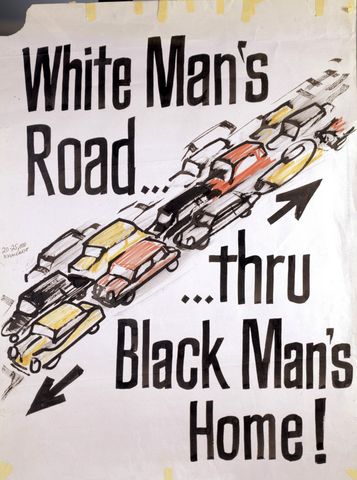DC Anti-Freeway Protests, late 1960s
 Washington, D.C., protest poster, drawn by Sammie Abbott, late 1960s. D.C. Community Archives, ECTC Collection, Washingtoniana Division, D.C. Public Library. The funeral program for Mr. Abbott's ( former mayor of Takoma Park) service is displayed in the Washington: Symbol and City exhibit at the National Building Museum (along with some other great images from the anti-freeway battle).
Washington, D.C., protest poster, drawn by Sammie Abbott, late 1960s. D.C. Community Archives, ECTC Collection, Washingtoniana Division, D.C. Public Library. The funeral program for Mr. Abbott's ( former mayor of Takoma Park) service is displayed in the Washington: Symbol and City exhibit at the National Building Museum (along with some other great images from the anti-freeway battle).This image (and a different, impressively large poster version is viewable in the Washingtoniana Collection of the DC Public Library) was digitized as part of the Smithsonian "America On the Move" exhibition. From the online text:
Often, proposals for the new interstate routes were met with concern from the public. In many cities, citizens formed coalitions to oppose the proposed routes. Some were successful at stopping construction or re-routing the highway, but most of the highways were built.
_______
My recollection is that proposals for the various freeways in Washington, DC called for the destruction of more than 100,000 buildings and the displacement of at least 200,000 people.
Residents owe quite a debt to the citizens of the "Emergency Committee on the Transportation Crisis" for doing what needed to be done to save the city.
I think about Detroit, my hometown, and how the city is scarred all about and neighborhoods divided, by freeways designed to quickly move people in and out of the city from points afar. To my way of thinking, Detroit today is exactly what the automobile industry wanted to have happen to cities.
Today the City of Detroit has less then 1/2 of its population during the peak, 1/3 of the land of the 177 square mile city is vacant, and more people leave the city each day to work than come into the city to work.
Today, by the way, is election day in Detroit.



0 Comments:
Post a Comment
<< Home